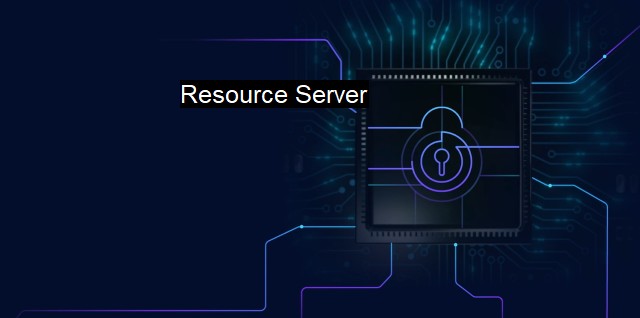What is Resource Server?
Understanding Resource Servers: Benefits and Security Challenges for Data Management and Distribution
In the context of cybersecurity and antivirus protection, the concept of a "Resource Server" proves crucial to understanding how resources and data are accessed and protected within a variety of computing networks. This exploration focuses on defining a resource server, its roles, functions, significance in the realm of cybersecurity and possible threats it may face from malicious entities.The term "Resource Server" refers to the server hosting various resources, data, and services, which are usually accessed by users via different applications. In the language of cybersecurity, resources define any services or data that have to be guarded from unauthorized access or exploitation. These resources can be software, images, databases, or even a piece of text on a webpage.
The role of the resource server is integral to the functioning of any web infrastructure. Servers interpret and process incoming requests by users or client applications, parse this information, and retrieve the exact data as required before making it available to these client requests. Whether the access demand is for a sophisticated software service or a simple HTML page, the resource server has the responsibility of delivering to these diverse user needs.
Within this sphere of functionality, the resource server plays a critical role in managing user access and controlling data transmission across the network to ensure security and privacy of confidential and sensitive information. One of the ways that this is achieved is by working closely with an authorization server. While the resource server delivers the requested data or service, it is the authorization server that verifies and authenticates the user requesting access. The tight integration between the two servers transforms into a robust environment, ensuring the legitimate and safe operation of the internet-facing application features while denying any unauthorized accesses.
One of the paramount concerns when dealing with resource servers is security. The very nature of resource servers—holding and manipulating a wealth of sensitive data—becomes appealing to cybercriminals. To protect against vulnerabilities, resource servers often implement rigid authorization and authentication procedures. This creates a strong fortification, impeding unauthorized access and cutting down the chance of data breaches or intrusions, which might cripple networks and potentially end in extensive loss of private and often financially valuable data.
On the contrary, resource servers can turn out to be a weak link and a liability if not protected adequately. Unprotected or poorly protected resource servers can be exploited using common cyberattacks such as Distributed Denial-of-Service (DDoS), Man-in-the-Middle (MitM), phishing attempts, or malware, which might lead to serious data breaches.
Antivirus solutions play a vital role in protecting resource servers from these threats. By installing and updating antivirus software regularly, resource servers can actively scan and block precarious programs, trojans, viruses, or other forms of malware that can disrupt their functionality or compromise the housed data. Advanced antivirus programs familiarity of known threats, bulwarked with mechanisms capable of identifying suspicious behavior and thwarting unknown threats, escalating the security wall fortifying the resource server.
To increase protection, employing encryption methods for data both at rest and in transit can provide an additional cybersecurity layer. This precautionary measure ensures that even when data is intercepted during transmission, the information remains conceivably impervious to attackers because of its encrypted nature.
Resource servers inhabit a highly valuable place in modern computer architecture, fulfilling exploits and protests against unauthorized access to a variety of resources through their capacity to interplay roles pertaining to service performance, processing requests, and precise data retrieval. Paramount to the security of these resource servers is the coordination with authorization counterparts, implementation of stringent access controls, antivirus software usage, and advanced encryption techniques, all combining to provide an impermeable defense against potential cyber threats.

Resource Server FAQs
What is a resource server in cybersecurity?
A resource server in cybersecurity is a server that stores and manages protected resources, such as files or sensitive data, and makes them available to authorized clients.How does a resource server protect against antivirus attacks?
A resource server can protect against antivirus attacks by implementing security measures, such as encryption, authentication, and access control, that restrict unauthorized access to the resources and prevent malware from infiltrating the system.What are some examples of resource servers in antivirus software?
Some examples of resource servers in antivirus software include virus signature databases, quarantine repositories, update servers, and file servers. These servers play a critical role in detecting, analyzing, and responding to cybersecurity threats.Why is it important to secure resource servers in antivirus systems?
It is important to secure resource servers in antivirus systems because these servers contain critical information and services that are essential to the operation of the antivirus software. If a resource server is compromised, it can lead to data breaches, malware infections, and other cybersecurity risks that can compromise the integrity, availability, and confidentiality of the entire system.| | A | | | B | | | C | | | D | | | E | | | F | | | G | | | H | | | I | | | J | | | K | | | L | | | M | |
| | N | | | O | | | P | | | Q | | | R | | | S | | | T | | | U | | | V | | | W | | | X | | | Y | | | Z | |
| | 1 | | | 2 | | | 3 | | | 4 | | | 7 | | | 8 | | |||||||